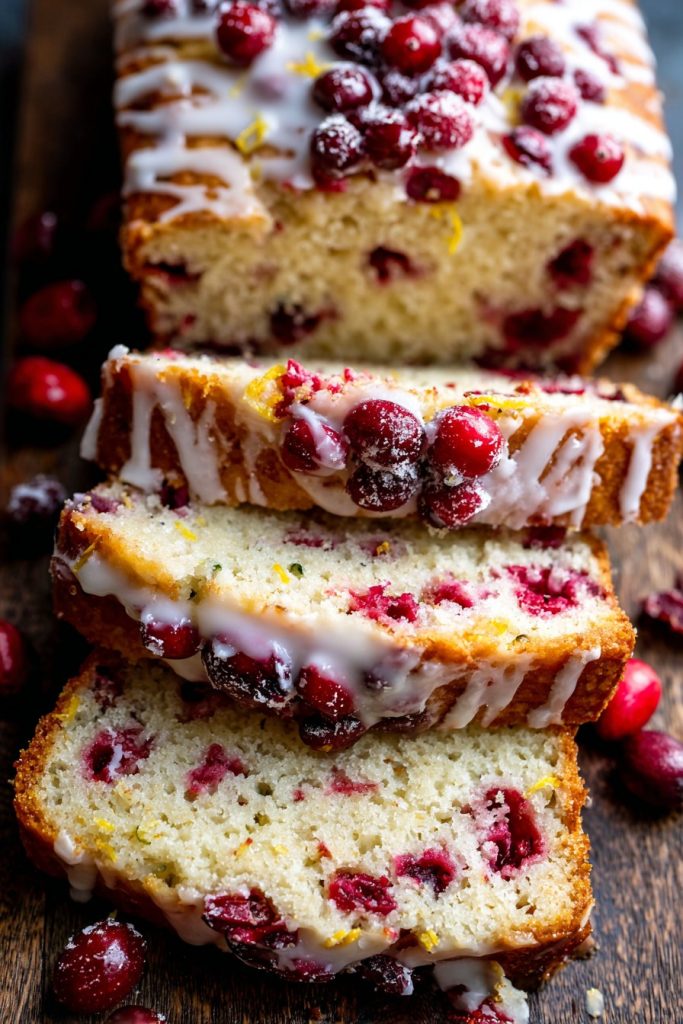Now is the perfect time for this cranberry lemon loaf. Nothing beats the combination of tart cranberries and bright lemon in a moist, tender quick bread. This recipe delivers consistent results with minimal effort.
Why This Recipe Works
- The combination of fresh lemon zest and juice provides a bright, citrus-forward flavor that complements the tart cranberries without overwhelming them
- Using both butter and sour cream creates a moist, tender crumb that stays fresh for days, preventing the dryness common in many quick breads
- The simple glaze made with lemon juice and powdered sugar adds a professional finish while reinforcing the citrus notes throughout each slice
- Folding frozen cranberries into the batter prevents them from sinking during baking and ensures even distribution in every piece
- The creaming method for the butter and sugar creates a light, airy texture that makes this loaf feel more like cake than traditional dense quick bread
Ingredients
- 2 cups all-purpose flour
- 1 ½ teaspoons baking powder
- ½ teaspoon baking soda
- ½ teaspoon salt
- ½ cup unsalted butter, softened to room temperature
- 1 cup granulated sugar
- 2 large eggs, room temperature
- 1 teaspoon vanilla extract
- ½ cup sour cream, room temperature
- ¼ cup fresh lemon juice
- 1 tablespoon lemon zest
- 1 ½ cups fresh or frozen cranberries
- 1 cup powdered sugar
- 2 tablespoons fresh lemon juice
Equipment Needed
- 9×5 inch loaf pan
- Parchment paper
- Mixing bowls
- Electric mixer or whisk
- Measuring cups and spoons
- Zester or fine grater
- Juicer or reamer
- Wire cooling rack
- Toothpick or cake tester
Instructions

Prepare the Pan and Preheat Oven
Begin by preheating your oven to 350°F. Line a 9×5 inch loaf pan with parchment paper, allowing some overhang on the sides for easy removal. Lightly grease any exposed areas of the pan with butter or cooking spray. This preparation ensures your loaf will release cleanly without sticking. While the oven heats, measure out all your ingredients to ensure everything is ready when needed. Having ingredients pre-measured and at room temperature creates a smoother mixing process and more consistent results. Room temperature ingredients incorporate more evenly, preventing overmixing which can lead to a tough texture.
Combine Dry Ingredients
Cream Butter and Sugar
Using an electric mixer on medium speed, beat ½ cup softened unsalted butter with 1 cup granulated sugar for 3-4 minutes until light and fluffy. The mixture should pale in color and increase in volume significantly. This creaming process incorporates air into the batter, which helps create a lighter texture in the final loaf. Scrape down the sides of the bowl periodically to ensure even mixing. The sugar crystals help aerate the butter, creating tiny air pockets that expand during baking. This step cannot be rushed – proper creaming is essential for the desired tender crumb.
Add Wet Ingredients
Beat in 2 large eggs one at a time, mixing well after each addition until fully incorporated. Add 1 teaspoon vanilla extract, ½ cup sour cream, ¼ cup fresh lemon juice, and 1 tablespoon lemon zest. Mix on low speed just until combined, being careful not to overmix at this stage. The sour cream adds moisture and tenderness while the lemon juice and zest provide the bright citrus flavor that defines this loaf. Scrape the bowl thoroughly to ensure all ingredients are evenly distributed. The batter may appear slightly curdled at this point, which is normal due to the lemon juice interacting with the dairy components.
Incorporate Dry Ingredients and Cranberries
Gradually add the flour mixture to the wet ingredients, mixing on low speed until just combined – about 15-20 seconds. Do not overmix. Gently fold in 1 ½ cups of cranberries using a spatula, being careful not to crush the berries. If using frozen cranberries, do not thaw them first as they will bleed color into the batter. The frozen berries help prevent overbaking the edges while the center cooks through. Spread the batter evenly into your prepared loaf pan, smoothing the top with a spatula. Tap the pan lightly on the counter to remove any large air bubbles.
Bake and Test for Doneness
Bake at 350°F for 55-65 minutes, rotating the pan halfway through baking. Begin checking for doneness at 55 minutes by inserting a toothpick into the center – it should come out clean or with a few moist crumbs attached. The top should be golden brown and spring back when lightly pressed. If the top browns too quickly, tent loosely with aluminum foil. The internal temperature should reach 200-205°F when measured with an instant-read thermometer. Remove from oven and cool in the pan on a wire rack for 15 minutes before transferring the loaf directly to the rack to cool completely.
Prepare and Apply Glaze
While the loaf cools, make the glaze by whisking together 1 cup powdered sugar and 2 tablespoons fresh lemon juice until smooth. The consistency should be thick but pourable – add more lemon juice one teaspoon at a time if too thick, or more powdered sugar if too thin. Once the loaf is completely cool to the touch, drizzle the glaze evenly over the top, allowing it to drip down the sides. Let the glaze set for at least 30 minutes before slicing. The glaze adds sweetness and enhances the lemon flavor while creating an attractive finished appearance.
Tips and Tricks
For optimal results, ensure all refrigerated ingredients reach true room temperature before beginning. Remove butter, eggs, and sour cream from refrigeration at least 1-2 hours before baking. Room temperature ingredients emulsify better, creating a smoother batter and more even texture. When zesting lemons, use only the bright yellow outer layer – the white pith beneath is bitter. Roll lemons firmly on the counter before juicing to maximize yield. For the most vibrant citrus flavor, use freshly squeezed lemon juice rather than bottled. When measuring flour, use the spoon-and-level method: spoon flour into your measuring cup, then level with a straight edge. Do not pack or tap the cup, as this compacts the flour and can lead to a dense loaf. If your cranberries are particularly large, consider chopping them in half to distribute more evenly throughout the batter. For easy removal, line your loaf pan with parchment paper with overhanging edges – this creates handles to lift the baked loaf out cleanly. When testing for doneness, use multiple methods: toothpick test, spring-back test, and internal temperature reading for certainty. If the top browns too quickly while the center remains underdone, tent with foil for the remaining baking time. For clean slices, use a serrated knife and wipe it clean between cuts. The loaf tastes even better the next day as flavors continue to develop and meld. Store completely cooled loaf wrapped in plastic wrap or in an airtight container at room temperature for up to 3 days, or freeze for up to 3 months. To freeze, wrap tightly in plastic wrap then aluminum foil, and thaw at room temperature when ready to serve.
Recipe Variations
- For a nutty variation, fold in ¾ cup chopped walnuts or pecans along with the cranberries. The nuts add crunch and complement the tart berries beautifully. Toast the nuts first for deeper flavor – spread on a baking sheet and toast at 350°F for 8-10 minutes until fragrant, then cool completely before adding to the batter.
- Create an orange cranberry loaf by substituting orange zest and juice for the lemon. Use 1 tablespoon orange zest and ¼ cup fresh orange juice in the batter, and orange juice in the glaze instead of lemon. The sweeter citrus profile pairs wonderfully with cranberries for a different flavor experience.
- Make a streusel topping by combining ¼ cup flour, ¼ cup brown sugar, 2 tablespoons cold butter, and ¼ teaspoon cinnamon until crumbly. Sprinkle over the batter before baking for a crunchy, sweet topping that adds texture contrast to the moist loaf.
- For a dairy-free version, replace butter with vegan butter sticks and sour cream with plain dairy-free yogurt. The results are nearly identical, with the same tender crumb and bright flavor profile. Use your favorite plant-based alternatives that you enjoy in other baking applications.
- Add warm spices by incorporating ½ teaspoon cinnamon, ¼ teaspoon nutmeg, and ⅛ teaspoon cardamom to the dry ingredients. These warming spices complement the tart cranberries and create a more complex flavor profile perfect for fall and winter baking.
Frequently Asked Questions
Can I use dried cranberries instead of fresh?
Yes, you can substitute dried cranberries, but the results will be different. Use 1 cup of dried cranberries instead of 1 ½ cups fresh, and soak them in hot water for 10 minutes before draining and patting dry. This plumps them up and prevents them from absorbing too much moisture from the batter. Dried cranberries will be sweeter and less tart than fresh, and they may sink more during baking. Toss them with 1 tablespoon of flour before folding into the batter to help prevent sinking. The texture and flavor profile will shift toward sweeter rather than tart.
Why did my loaf sink in the middle?
A sunken center typically indicates underbaking or too much leavening. Ensure your baking powder and soda are fresh – they lose potency over time. Test by mixing ½ teaspoon baking powder with ¼ cup hot water; it should bubble vigorously. Also verify your oven temperature with an oven thermometer, as inaccurate temperatures affect rising. Do not open the oven door during the first 45 minutes of baking, as temperature fluctuations can cause collapsing. Finally, ensure you’re using the correct pan size – a smaller pan causes overflow and improper baking.
Can I make this recipe as muffins instead?
Absolutely. Divide the batter among 12 standard muffin cups lined with paper liners. Bake at 375°F for 18-22 minutes until a toothpick inserted in the center comes out clean. The higher temperature helps the muffins rise properly and develop nice domed tops. Reduce the cranberries to 1 cup for better distribution in smaller portions. Check for doneness a few minutes early as muffins bake faster than loaves. The glaze can be applied the same way once cooled. Muffins will stay fresh for 2-3 days at room temperature.
How do I prevent the cranberries from sinking?
Can I freeze the baked loaf?
Yes, this loaf freezes exceptionally well. Cool completely after baking, then wrap tightly in plastic wrap followed by aluminum foil. Freeze for up to 3 months. Thaw overnight in the refrigerator or at room temperature for 4-6 hours. For best results, freeze before glazing and add the glaze after thawing. You can also freeze individual slices for quick single servings – wrap each slice separately and remove as needed. The texture and flavor remain excellent after freezing, making this a great make-ahead option for holidays or busy weeks.
Summary
This cranberry lemon loaf combines tart berries with bright citrus in a moist, tender quick bread. Simple techniques ensure consistent results with professional appearance. The lemon glaze adds sweetness and enhances flavor. Perfect for breakfast, snacking, or dessert.
Cranberry Lemon Loaf
4
servings20
minutes60
minutesIngredients
Instructions
- 1 Preheat oven to 350°F. Line 9x5 inch loaf pan with parchment paper.
- 2 Whisk flour, baking powder, baking soda, and salt in medium bowl.
- 3 Cream butter and sugar until light and fluffy, about 3-4 minutes.
- 4 Beat in eggs one at a time, then vanilla, sour cream, lemon juice, and zest.
- 5 Add flour mixture, mix until just combined. Fold in cranberries.
- 6 Bake 55-65 minutes until toothpick comes out clean. Cool completely.
- 7 Whisk powdered sugar and lemon juice for glaze. Drizzle over cooled loaf.



